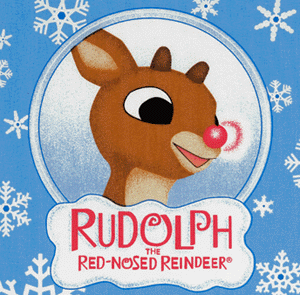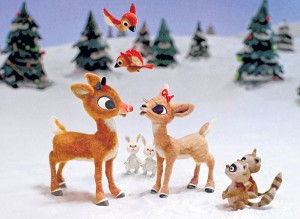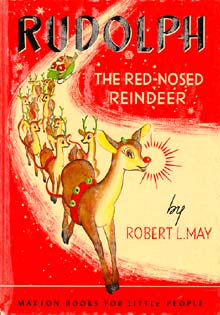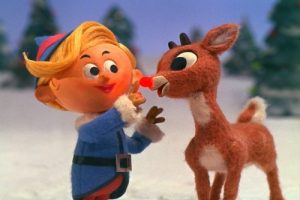Rudolph the Red-Nosed Reindeer
Rudolph, the red-nosed Reindeer

had a very shiny nose
And if you ever saw him,
you would even say it glows.
All of the other reindeer
used to laugh and call him names.
They never let poor Rudolph
play in any reindeer games.
Then one foggy Christmas eve
Santa came to say:
“Rudolph with your nose so bright, won’t you guide my sleigh tonight?”
Then all the reindeer loved him as they shouted out with glee:
“Rudolph the red-nosed reindeer, you’ll go down in history!”
There’s Always Tomorrow

There’s always tomorrow
For dreams to come true
Believe in your dreams, come what may.
There’s always tomorrow
WIth so much to do
And so little time in a day.
We all pretend the rainbow has an end
And you’ll be there, my friend, some day.
There’s always tomorrow
For dreams to come true
Tomorrow is not far away.
We all pretend the rainbow has an end
And you’ll be there, my friend, some day
There’s always tomorrow
For dreams to come true
Tomorrow is not far away.
History
 Rudolph the Red-Nosed Reindeer is a legendary reindeer, created by Robert Lewis May, usually depicted as a young fawn who barely has antlers, with a glowing red nose, popularly known as “Santa’s ninth reindeer.” When depicted, he is the lead reindeer pulling Santa’s sleigh on Christmas Eve. The luminosity of his nose is so great that it illuminates the team’s path through inclement winter weather.
Rudolph the Red-Nosed Reindeer is a legendary reindeer, created by Robert Lewis May, usually depicted as a young fawn who barely has antlers, with a glowing red nose, popularly known as “Santa’s ninth reindeer.” When depicted, he is the lead reindeer pulling Santa’s sleigh on Christmas Eve. The luminosity of his nose is so great that it illuminates the team’s path through inclement winter weather.
Rudolph first appeared in a 1939 booklet written by Robert L. May and published by Montgomery Ward, the department store.
The story chronicles the experiences of Rudolph, a youthful reindeer buck (male) who possesses an unusual luminous red nose. Mocked and excluded by his peers because of this trait, Rudolph manages to prove himself one Christmas Eve with poor visibility due to inclimate weather after Santa Claus catches sight of Rudolph’s nose and asks Rudolph to lead his sleigh for the evening. Rudolph agrees, and is finally treated better by his fellow reindeer for his heroism and accomplishment.
Rudolph made his first screen appearance in 1948, in a cartoon short produced by Max Fleischer for the Jam Handy Corporation that was more faithful to May’s original story than Marks’ song, which had not yet been written. It was reissued in 1951 with the song added.
May’s brother-in-law, Johnny Marks, adapted the story of Rudolph into a song. Gene Autry’s recording of the song hit No. 1 on the Billboard pop singles chart the week of Christmas 1949. Autry’s recording sold 2.5 million copies the first year, eventually selling a total of 25 million, and it remained the second best-selling record of all time until the 1980s.
DC Comics published a series of 13 annuals titled Rudolph the Red-Nosed Reindeer from 1950 to 1962. Rube Grossman drew most of the 1950s stories. In 1972, they published a 14th edition in an extra-large format. Subsequently, they published six more in that format: Limited Collectors’ Edition
In 1958, Little Golden Books published an illustrated storybook, adapted by Barbara Shook Hazen and illustrated by Richard Scarry. The book, similar in story to the Max Fleischer cartoon short, is no longer in print,[citation needed] but a revised Little Golden Books version of the storybook was reissued in 1972.
Perhaps the most well-known version of all the Rudolph adaptations is the Rankin/Bass Productions version of 1964.Filmed in Japan, with all sound recordings done in Toronto, Canada, the show premièred on NBC. As the producers of the special only had the song as source material and did not have a copy of the original book, they interpolated an original story around the central narrative of the song, one that differed from the book. This re-telling chronicles Rudolph’s social rejection among his peers and his decision to run away from home. Rudolph is accompanied by a similarly outcast elf named Hermey, whose dreams of becoming a dentist are shunned by the other elves, along with a loud, boisterous, eager prospector named Yukon Cornelius who was in search of wealth. Additional original characters include Rudolph’s love interest, Clarice; the antagonistic “Abominable Snow Monster”; and, as narrator, the living Sam the Snowman, voiced by Burl Ives.

In the 1964 stop-motion movie, Rudolph is born to Donner the Reindeer and Donner’s wife. He is discovered by Santa to have a shiny, glowing red nose. Donner, regardless of Rudolph’s defect, trains him to be a normal reindeer with skills such as gathering food and hiding from the “Abominable Snow Monster”, a giant, furry white beast. To hide Rudolph’s nose, Donner puts dirt on it to cover it with a black coating. This causes Rudolph to talk in a funny accent, as told by the Rudolph’s peers. A short time later, Rudolph joins his peers at the Reindeer Games, where he meets Fireball, who is initially friendly and has a shock of strawberry blond hair on his head, and Clarice, a female spectator who takes a liking to Rudolph. Clarice’s flirtation inspires Rudolph to perform better than all of his peers at flying, but in his excitement he knocks the black cover off his nose, revealing a red glow that causes Fireball and the others to turn against him; this distraction, in turn, prompts the coach (Comet) to ban Rudolph from the Reindeer Games. Clarice remains loyal to him, only to be ordered by her father not to shame the family by associating with “a red-nosed reindeer.”
Rudolph soon runs into Hermey, an elf who was forced out of his job at the North Pole’s toy factory; Hermey showed a total lack of interest in the toymaking and singing aspects of being an elf and instead wanted to pursue dentistry. They come to the conclusion that they’re both misfits and decide to run away together. On their aimless journey, they run into Yukon Cornelius, the self-described “greatest prospector of the North” who nevertheless seems to never find any silver or gold, and attempt to stay away from the Bumble, a huge abominable snow monster. Their journey leads them to the Island of Misfit Toys, where sentient but unorthodox toys go when they are abandoned by their owners. King Moonracer, the winged lion that lords over the Island, refuses to let them stay there permanently, instead telling the trio to return home and tell Santa Claus of the toys’ plight, in exchange for one night’s stay on the island. Rudolph refuses the offer and, fearing for his friends’ life, runs off alone.
A now older Rudolph, still unable to find a place in the world, returns home to the North Pole, only to find that his family and Clarice had left to look for him and are now about to be eaten by the Bumble. With the help of Hermey and Yukon (who arrived separately), they lure the Bumble away and pacify him by knocking him unconscious and allowing Hermey (with dental skills he has acquired by reading books) to remove his sharp teeth. Everyone eventually returns to Santa’s workshop, where a dismayed Santa Claus breaks the bad news that the weather is too bad to take the sleigh out and that Christmas would be canceled. Santa changes his mind when he notices Rudolph’s red nose and asks Rudolph to lead the sleigh team, which he happily accepts.
After the story’s initial broadcast, its closing credits were revised. Images of wrapped presents being dropped from Santa’s sleigh were replaced by a scene in which Santa stops to pick up the Misfit Toys and delivers them to the homes of children below, where they were found by children who loved them. The changes were prompted by viewer feedback pleading for a happy ending for each toy. The special now airs annually on CBS, rather than NBC, and is hailed as a classic by many. The special’s original assortment of characters have acquired iconic status, and an uncertainty surrounding an error in the special’s copyright has allowed the special to be widely parodied and imitated in the decades since its original airing.
The sequel Rudolph’s Shiny New Year (premier air date December 10, 1976) continued the reindeer’s journeys, and the series was made into a trilogy with the 1979 feature-length film Christmas in July, which integrated the Rudolph universe into that of Rankin/Bass’s adaptation of Frosty the Snowman.
The story is owned by The Rudolph Company, LP and has been adapted in numerous forms including a popular song, the iconic 1964 television special and sequels, and a feature film and sequel. Character Arts, LLC manages the licensing for the Rudolph Company, LP. In many countries, Rudolph has become a figure of Christmas folklore. 2014 marked the 75th anniversary of the character and the 50th anniversary of the television special. A series of postage stamps featuring Rudolph was issued by the United States Postal Service on November 6, 2014.
Family
Donner (father in 1964 film)
Mrs. Donner (mother in 1964 film)
Blitzen (father in 1998 film)
Mitzi (mother in 1998 film)
Rusty (brother in Holidaze: The Christmas That Almost Didn’t Happen)
Arrow (cousin in 1998 film)
Comet, Cupid and Dasher (uncles in 1998 film)
Leroy, the Redneck Reindeer (cousin from the Joe Diffie song of the same name, on the album, Mr. Christmas)
Spouse(s) Clarice (in 1964 film and 2001 film)/Zoey in Rudolph the Red-Nosed Reindeer: The Movie
Children Robbie (son in the Robbie the Reindeer films)
Parents
Robert L. May’s original book does not name Rudolph’s parents.
The animated specials produced by both Rankin/Bass and GoodTimes Entertainment have given Rudolph different sets of parents:
In Rankin/Bass’s holiday special, he is Donner’s son, and his mother is a tan doe who is called Mrs. Donner.
In GoodTimes’ retelling, Rudolph’s father is Blitzen, and his mother is named Mitzi.
Offspring
Three BBC animations carry on the legend by introducing Rudolph’s son, Robbie the Reindeer. However, Rudolph is never directly mentioned by name (references are replaced by the first and second films’ villain Blitzen interrupting with the phrase, “Don’t say that name!”, or something similar, presumably for copyright reasons.)
Siblings
Rudolph is also given a younger brother, Rusty Reindeer, in the American special, Holidaze: The Christmas That Almost Didn’t Happen (2006). Unlike in the “Robbie the Reindeer” cartoons, Rudolph’s name is mentioned in the film.
Michael Fry and T. Lewis have given Rudolph another brother in a series of Over the Hedge comic strips: an overweight, emotionally damaged reindeer named Ralph, the Infra-Red nosed Reindeer, who is referred to as Rudolph’s older brother. Ralph’s red nose is good for defrosting Santa’s sleigh and warming up toast and waffles; he enviously complains about his brother Rudolph’s publicity and his own anonymity.
Aunts, uncles, and cousins
Rudolph has a cousin, Leroy, in Joe Diffie’s 1995 song, “Leroy the Redneck Reindeer” (1995), which tells the story of Leroy’s joining the sleigh team to substitute for Rudolph, who was ill.
In GoodTimes’ retelling, three of Santa’s reindeer (Dasher, Comet, and Cupid) are his uncles, and Cupid’s son Arrow is Rudolph’s cousin and rival.
history source: from wikipedia, the free encyclopedia
